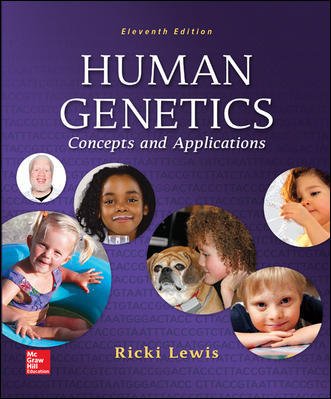Human Genetics Concepts And Applications 11Th Edition By Lewis – Test Bank
Chapter 12
Gene Mutation
Multiple Choice Questions
- A mutation is
A.
a change in a DNA sequence that affects at least 90 percent of individuals in a population.
a change in a DNA sequence that is rare in a population.
-
a change in a DNA sequence that harms health.
D.a type of radiation that can alter the genetic code.
Bloom’s Level: 02. Understand
Learning Outcome: 12.01 Distinguish between mutation and mutant.
Section: 12.01
Topic: Mutations and polymorphisms
- Mutations and polymorphisms are both changes in a DNA sequence, but polymorphisms are more common because
A.they less severely affect the phenotype, so that individuals can reproduce and transmit them.
B. more people have them.
C. mutations are always lethal.
D.
mutations refer to a real situation, whereas a polymorphism is an idealized state hypothesized by biologists to explain genetic change.
Bloom’s Level: 02. Understand
Learning Outcome: 12.02 Distinguish between mutation and polymorphism.
Section: 12.01
Topic: Mutations and polymorphisms
- An example of a beneficial mutation is
A.a mutation in collagen that causes the skin to be extra stretchy.
B. the mutation that causes sickle cell disease.
C.
a mutation in the CCR5 gene.
- a mutation in a cytokine gene that causes an allergy.
Bloom’s Level: 01. Remember
Learning Outcome: 12.02 Distinguish between mutation and polymorphism.
Section: 12.01
Topic: Mutations and polymorphisms
- A germline mutation passes from generation to generation because it occurs during the DNA replication before
A.mitosis.
B. meiosis.
C. fertilization.
D. RNA replication.
Bloom’s Level: 02. Understand
Learning Outcome: 12.02 Distinguish between mutation and polymorphism.
Section: 12.01
Topic: Mutations and polymorphisms
- A somatic mutation
A.occurs only in microbes.
B. affects a particular subset of cells.
C. affects all cells of an individual.
D. is expressed only in embryos.
Bloom’s Level: 02. Understand
Learning Outcome: 12.02 Distinguish between mutation and polymorphism.
Section: 12.01
Topic: Mutations and polymorphisms
The first single-gene disorder for which the mechanism of mutation was understood at a molecular level was
-
cystic fibrosis.
B. hemophilia.
C. sickle cell disease.
D. diabetes mellitus.
Bloom’s Level: 01. Remember
Learning Outcome: 12.03 Describe mutations in the genes that encode beta globin and collagen.
Section: 12.02
Topic: Mutations and polymorphisms
- The mutation that causes sickle cell disease
A.occurs in the same gene that, when mutant in a different way, causes beta thalassemia.
B. deletes two contiguous DNA bases.
C. results in a single DNA base change that does not alter the encoded amino acid.
D. changes a glutamic acid to a valine in the alpha globin gene.
Bloom’s Level: 02. Understand
Learning Outcome: 12.03 Describe mutations in the genes that encode beta globin and collagen.
Section: 12.02
Topic: Mutations and polymorphisms
- Sanjay and Indira have thalassemia minor. Their young daughters are dizygotic (fraternal) twins. Malonie has thalassemia minor like her parents, but Jewel has the more severe thalassemia major. The more serious case most likely arose because
A.Jewel inherited two wild type alleles from her carrier parents.
B. Jewel inherited a dominant form of the condition.
C. Jewel inherited two recessive mutant alleles in the beta globin gene that cause thalassemia.
D. Jewel also has sickle cell disease.
Bloom’s Level: 04. Analyze
Learning Outcome: 12.03 Describe mutations in the genes that encode beta globin and collagen.
Section: 12.02
Topic: Mutations and polymorphisms
- A mutation in a collagen gene is likely to affect the phenotype because
A.it is extremely rare.
B. during meiosis, the chromosome that bears the mutation is more likely to enter a gamete than the chromosome that carries the wild type allele.
C. collagen has a very precise three-dimensional structure, so nearly any disruption alters the overall conformation.
D. people who use cosmetics with collagen silence collagen genes.
Bloom’s Level: 02. Understand
Learning Outcome: 12.03 Describe mutations in the genes that encode beta globin and collagen.
Section: 12.02
Topic: Mutations and polymorphisms
10. The parents-to-be were shocked when an ultrasound scan done in the second trimester of the pregnancy showed a fetus with obviously broken leg bones and ribs. The doctor diagnosed osteogenesis imperfecta. This is caused by a mutation in a gene that encodes
A. beta globin.
B. a clotting factor.
C. myosin.
D. collagen.
Bloom’s Level: 03. Apply
Learning Outcome: 12.03 Describe mutations in the genes that encode beta globin and collagen.
Section: 12.02
Topic: Mutations and polymorphisms











Reviews
There are no reviews yet.